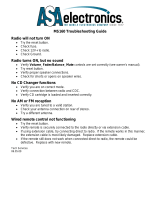
15
English
Consumer Product Safety Guide
CAUTION
The battery used in this device may present a risk of re, explosion or chemical burn if
mistreated.
• Never use or charge the battery if it appears to be leaking, discolored, deformed,
or in any way abnormal.
• Never disassemble the unit or attempt to remove battery as that could cause
leakage of alkaline solution or other electrolytic substance.
• Always conrm that the temperature is 5°C – 35° C (41° - 95° Fahrenheit) before
you charge the battery. Leakage or deterioration of the battery may occur if this
warning is not heeded.
• Never expose the battery to any liquid.
• Never expose the battery to excessive heat such as direct sunlight or re.
• Never use the battery pack in an unventilated vehicle where excessive internal
temperatures may be encountered.
• Always keep the battery out of the reach of infants and small children.
Safety Instructions
1. Water and Moisture – The unit should not be used near water. For example: near
a bathtub, washbowl, kitchen sink, laundry tub, swimming pool or in a wet
basement.
2. Ventilation – The unit should be situated so that its location or position does not
interfere with its proper ventilation. For example, it should not be situated on a
bed, sofa, rug or similar surface that may block ventilation openings. Also, it
should not be placed in a built-in installation, such as a bookcase or cabinet,
which may impede the ow of air through the ventilation openings.
3. Heat – The unit should be situated away from heat sources such as radiators,
heat registers, stoves or other appliances (including ampliers) that produce
heat.
4. Power Sources – The unit should be connected to a power supply only of the
type described in the operating instructions or as marked on the appliance.
5. Power Cable Protection – Power supply cables should be routed so that they are
not likely to be walked on or pinched by items placed upon or against them. It is
always best to have a clear area from where the cable exits the unit to where it is
plugged into an AC socket.
6. Cleaning – The unit should be cleaned only as recommended. See the
Maintenance section of this manual for cleaning instructions.
7. Objects and Liquid Entry – Care should be taken so that objects do not fall and
liquids are not spilled into any openings or vents located on the product.
8 Attachments – Do not use attachments not recommended by the product
manufacturer.
9 Lightning and Power Surge Protection – Unplug the unit from the wall socket
and disconnect the antenna or cable system during a lightning storm or when it
is left unattended and unused for long periods of time. This will prevent damage
to the product due to lightning and power-line surges.
10. Overloading – Do not overload wall sockets, extension cords, or integral
convenience receptacles as this can result in a risk of re or electric shock.
11. Damage Requiring Service – The unit should be serviced by qualied service
personnel when:
A. the power supply cable or plug has been damaged.
B. objects have fallen into or liquid has been spilled into the enclosure.
C. the unit has been exposed to rain.
D. the unit has been dropped or the enclosure damaged.
E. the unit exhibits a marked change in performance or does not operate normally.
12. Antenna – Do not connect an external antenna to the unit (other than that
provided).
13. Periods of None Use – If the unit is to be left unused for an extended period of
time, such as a month or longer, the power cable should be unplugged from the
unit to prevent damage or corrosion.
14. Servicing – The user should not attempt to service the unit beyond those
methods described in the user’s operating instructions. Service methods not
covered in the operating instructions should be referred to qualied service
personnel.
Internal Rechargeable Lithium-ion Battery
This device uses an internal rechargeable lithium-ion battery that should last the
lifetime of the device. If you suspect your battery may be dead, try charging it several
times. If the battery does not recharge, please contact us for repair information.
WARNING/DISPOSAL OF UNIT
Please do NOT attempt to change the battery yourself. If the battery has died and you
do not want us to replace your battery, you should follow the disposal instructions
below:
• Never dispose of used batteries/electronics with ordinary solid wastes, since they
contain toxic substances.
• Always dispose of used batteries/electronics in accordance with the prevailing
community regulations that apply to the disposal of batteries/electronics. If
there are no local regulations concerning battery/electronics disposal, please
dispose of the device in a waste bin for electronic devices.
• Many electronics retailers now recycle batteries and other electronic compo-
nents at no charge. Check to see which ones in your area do so.
iW1 08042011-0(UK)

















